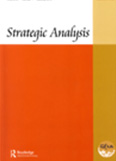Sailing through the Northern Sea Route: Opportunities and Challenges
Because of global warming, the thinning ice in the Arctic is opening up the region for navigation for a few months in the summer season. The Arctic littoral countries (Canada, Norway, Denmark [Greenland], Russia and the United States), shipping companies and several other stakeholders (the EU and Asian countries such as China, Japan, Singapore and South Korea) are closely tracking shipping related developments in the Arctic and developing strategies to exploit the Northern Sea Route (NSR).
- V Sakhuja
- July 2013
- Strategic Analysis








